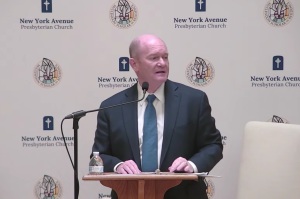Archdiocese of Miami calls for hate crime investigation after statue of Jesus found headless

The Archdiocese of Miami is calling for a “hate crime” investigation after vandals beheaded a statue of Jesus at a church, adding to a string of attacks on Catholic monuments nationwide.
Deacon Edivaldo da Saliva of the Good Shepherd Catholic Church in West Kendall, told Local 10 that he found the headless statue of the Savior on Wednesday morning and condemned it as a part of an ongoing attack on church monuments nationwide.
"This morning I found it on the ground, and we presume that it is vandalism," da Saliva said. "We have seen this happening all over the country."
The Archdiocese of Miami now wants police to investigate the vandalized statue “as a hate crime.”
"Archbishop Thomas Wenski is requesting this investigation be considered a hate crime," Mary Ross Agosta, director of communications for the Archdiocese of Miami, told Fox News. "The statue, located outside the church, was on private and sacred property."
The attack on the Miami church’s statue of Jesus comes in the wake of similar attacks against other monuments to saints and biblical figures.
Last weekend a statue of the Virgin Mary was also beheaded at a parish in Chattanooga, Tennessee, becoming the third such attack, the Catholic News Agency reported.
Fr. Manuel Perez, pastor of St. Stephen Catholic Church, said he found the headless Virgin Mary while walking the church grounds in preparation for mass last Saturday morning.
“Fr. Perez said that he looked around the church grounds to see if he could find a missing head and he couldn't locate it,” Jim Wogan, director of communications for the Diocese of Knoxville, told CAN about the vandalized $2,000 statue of the Holy Mother.
A statue of Mary was set on fire in Boston, Massachusetts, while in Brooklyn, New York, another statue was tagged with the word “IDOL” in black spray paint.
Wogan said the attacks were happening at a “very chaotic time in our history,” noting that “anger seems to be sort of a default setting for people right now.”
“I think our bishop and our pastors would hope that people would remember the sort of example that is set in the Gospels — that, we're to treat each other as we'd want to be treated,” he said.
Last month, the Archdiocese of St. Louis in Missouri was forced to defend the statue of King Louis IX of France located in front of the St. Louis Art Museum in Forest Park as praying Catholics clashed with protesters seeking to tear it down.
“For those unfamiliar with King Louis IX he was a rabid anti-semite who spearheaded many persecutions against the Jewish people. Centuries later Nazi Germany gained inspiration and ideas from Louis IX as they embarked on a campaign of murderous genocide against the Jewish people. Louis IX was also vehemently Islamophobic and led a murderous crusade against Muslims which ultimately cost him his life,” a change.org petition seeking to change the name of St. Louis the city and remove the statue, said.
In a statement defending the king, the Archdiocese of St. Louis called him a saint who reverenced God and did much to care for the poor.
“The history of the statue of St. Louis, the King is one founded in piety and reverence before God, and for non-believers, respect for one’s neighbor. The reforms that St. Louis implemented in French government focused on impartial justice, protecting the rights of his subjects, steep penalties for royal officials abusing power, and a series of initiatives to help the poor. King Louis IX’s renowned work in charity helped elevate him to Sainthood,” the archdiocese explained.
“King Louis IX’s renowned work in charity helped elevate him to Sainthood,” the St. Louis Archdiocese continued. “His daily suppers were shared with numerous beggars, whom he invited to the royal table. On many evenings, he would not let them leave before he washed their feet. He personally paid to feed more than 100 poor Parisians every day. His care for the sick was equally moving; St. Louis frequently ministered to lepers. He also created a number of hospitals, including one for the blind and another for ex-prostitutes,” the statement added.



























